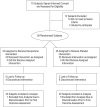A randomized, double-blind, placebo-controlled trial of eszopiclone for the treatment of insomnia in patients with chronic low back pain
- PMID: 24882900
- PMCID: PMC4015379
- DOI: 10.5665/sleep.3760
A randomized, double-blind, placebo-controlled trial of eszopiclone for the treatment of insomnia in patients with chronic low back pain
Abstract
Study objectives: Insomnia, which is very common in patients with chronic low back pain (LBP), has long been viewed as a pain symptom that did not merit specific treatment. Recent data suggest that adding insomnia therapy to pain-targeted treatment should improve outcome; however, this has not been empirically tested in LBP or in any pain condition treated with a standardized pain medication regimen. We sought to test the hypothesis that adding insomnia therapy to pain-targeted treatment might improve sleep and pain in LBP.
Design: Double-blind, placebo-controlled, parallel-group, 1-mo trial.
Setting: Duke University Medical Center Outpatient Sleep Clinic.
Patients: Fifty-two adult volunteers with LBP of at least 3 mo duration who met diagnostic criteria for insomnia (mean age: 42.5 y; 63% females).
Interventions: Subjects were randomized to eszopiclone (ESZ) 3 mg plus naproxen 500 mg BID or matching placebo plus naproxen 500 mg twice a day.
Measurements and results: ESZ SIGNIFICANTLY IMPROVED TOTAL SLEEP TIME (MEAN INCREASE: ESZ, 95 min; placebo, 9 min) (primary outcome) and nearly all sleep measures as well as visual analog scale pain (mean decrease: ESZ, 17 mm; placebo, 2 mm) (primary pain outcome), and depression (mean Hamilton Depression Rating Scale improvement ESZ, 3.8; placebo, 0.4) compared with placebo. Changes in pain ratings were significantly correlated with changes in sleep.
Conclusions: The addition of insomnia-specific therapy to a standardized naproxen pain regimen significantly improves sleep, pain, and depression in patients with chronic low back pain (LBP). The findings indicate the importance of administering both sleep and pain-directed therapies to patients with LBP in clinical practice and provide strong evidence that improving sleep disturbance may improve pain.
Trial registration: clinicaltrials.gov identifier: NCT00365976.
Keywords: eszopiclone; insomnia; low back pain.
Similar articles
-
Eszopiclone coadministered with escitalopram in patients with insomnia and comorbid generalized anxiety disorder.Arch Gen Psychiatry. 2008 May;65(5):551-62. doi: 10.1001/archpsyc.65.5.551. Arch Gen Psychiatry. 2008. PMID: 18458207 Clinical Trial.
-
A 12-week, randomized, double-blind, placebo-controlled study evaluating the effect of eszopiclone 2 mg on sleep/wake function in older adults with primary and comorbid insomnia.Sleep. 2010 Feb;33(2):225-34. doi: 10.1093/sleep/33.2.225. Sleep. 2010. PMID: 20175406 Free PMC article. Clinical Trial.
-
Eszopiclone for the treatment of posttraumatic stress disorder and associated insomnia: a randomized, double-blind, placebo-controlled trial.J Clin Psychiatry. 2011 Jul;72(7):892-7. doi: 10.4088/JCP.09m05607gry. Epub 2011 Feb 22. J Clin Psychiatry. 2011. PMID: 21367352 Clinical Trial.
-
Eszopiclone for late-life insomnia.Clin Interv Aging. 2007;2(3):313-26. Clin Interv Aging. 2007. PMID: 18044182 Free PMC article. Review.
-
Eszopiclone for the treatment of primary insomnia: a systematic review and meta-analysis of double-blind, randomized, placebo-controlled trials.Sleep Med. 2019 Oct;62:6-13. doi: 10.1016/j.sleep.2019.03.016. Epub 2019 Apr 6. Sleep Med. 2019. PMID: 31518944
Cited by
-
The assessment and management of insomnia: an update.World Psychiatry. 2019 Oct;18(3):337-352. doi: 10.1002/wps.20674. World Psychiatry. 2019. PMID: 31496087 Free PMC article.
-
Chronic Pain and Sleep Disorders in Primary Care.Pain Res Treat. 2017;2017:9081802. doi: 10.1155/2017/9081802. Epub 2017 Dec 19. Pain Res Treat. 2017. PMID: 29410915 Free PMC article.
-
Association of insomnia and daytime sleepiness with low back pain: A bidirectional mendelian randomization analysis.Front Genet. 2022 Oct 4;13:938334. doi: 10.3389/fgene.2022.938334. eCollection 2022. Front Genet. 2022. PMID: 36267398 Free PMC article.
-
Nonpharmacological Treatments of Insomnia for Long-Term Painful Conditions: A Systematic Review and Meta-analysis of Patient-Reported Outcomes in Randomized Controlled Trials.Sleep. 2015 Nov 1;38(11):1751-64. doi: 10.5665/sleep.5158. Sleep. 2015. PMID: 25902806 Free PMC article.
-
Causal association of sleep disturbances and low back pain: A bidirectional two-sample Mendelian randomization study.Front Neurosci. 2022 Dec 2;16:1074605. doi: 10.3389/fnins.2022.1074605. eCollection 2022. Front Neurosci. 2022. PMID: 36532278 Free PMC article.
References
-
- Rives PA, Douglass AB. Evaluation and treatment of low back pain in family practice. J Am Board Fam Pract. 2004;17:S23–31. - PubMed
-
- Andersson GB. Epidemiological features of chronic low-back pain. Lancet. 1999;354:581–5. - PubMed
-
- Chou R, Qaseem A, Snow V, et al. Diagnosis and treatment of low back pain: a joint clinical practice guideline from the American College of Physicians and the American Pain Society. Ann Intern Med. 2007;147:478–91. - PubMed
-
- Bahouq H, Allali F, Rkain H, Hmamouchi I, Hajjaj-Hassouni N. Prevalence and severity of insomnia in chronic low back pain patients. Rheumatol Int. 2013;33:1277–81. - PubMed
-
- Smith MT, Haythornthwaite JA. How do sleep disturbance and chronic pain inter-relate? Insights from the longitudinal and cognitive-behavioral clinical trials literature. Sleep Med Rev. 2004;8:119–32. - PubMed
Publication types
MeSH terms
Substances
Associated data
LinkOut - more resources
Full Text Sources
Other Literature Sources
Medical
Miscellaneous


